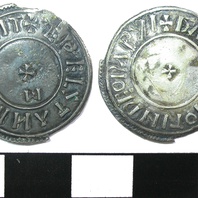
Viking Objects
Silver Penny (1914/543-1)
This silver penny of King Aethelstan, who was King of England from 927-939, was minted in Derby by the moneyer Gadierd between 937-939. It is not known where it was found. Moneyers were people who were permitted to mint money on behalf of the king. Minting coins was a way of controlling the means of exchange within a kingdom and which created a more easily administered standardized system of trade. Moreover, the coins themselves were often used as propaganda, portaying symbols and statements that gave off a desired message. The Vikings later used the minting of coins to legitimize their own rule.
Read More

Viking Objects
Coin of Cnut the Great (NARC-9AE391)
This silver Helmet IIIc Type penny was minted for King Cnut of England by the moneyer Eadwine in Thetford. The obverse displays + CNUT RECXA with a figure wearing a pointed helmet. The reverse displays + EDPINE ON DEOD and a voided short cross. Minting coins was a way of controlling the means of exchange within a kingdom and which created a more easily administered standardized system of trade. Moreover, the coins themselves were often used as propaganda, portaying symbols and statements that gave off a desired message. The Vikings later used the minting of coins to legitimize their own rule.
Read More
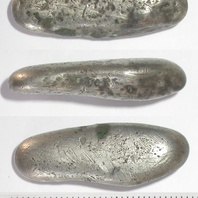
Viking Objects
Silver Ingot (DENO-CE6103)
This silver ingot was made by melting down worked silver and casting it in an open mould. The Vikings arriving in England had a bullion economy in which they paid for goods with silver that was weighed to an amount agreed between the buyer and the seller. Hacksilver and silver ingots are the most common evidence for their bullion economy. It took some time for the Scandinavian settlers to adopt a monetary economy like that of the Anglo-Saxons, and both systems were used simultaneously for a while before they fully adopted the new system. The Vikings were familiar with monetary economies but they treated coins as just another form of silver before adoption of a monetary economy.
Read More
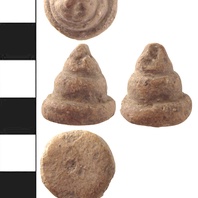
Viking Objects
Cast Lead Weight (SWYOR-A48576)
A cast lead-alloy weight or possible gaming piece in the form of a cone made of three levels. It is perhaps an indicator of the Scandinavian bullion economy. Weights are an important form of evidence for Viking Age commerce and the use of standards across the different economic systems within which Vikings were integrated. Many of the weights discovered, particularly ones in Ireland and those of Arabic type, suggest that a standardized system of weights existed in some areas. These standard weights, alongside standard values of silver, are what allowed the bullion economy of Viking occupied areas to function. A bullion economy was a barter economy that relied on the exchange of set amounts of precious metal in various forms, such as arm-rings or coins, for tradable goods, such as food or textiles. Each merchant would have brought their own set of weights and scales to a transaction to make sure that the trade was conducted fairly.
Read More
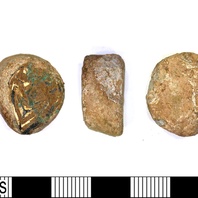
Viking Objects
Gilded Lead-Alloy Weight (LEIC-C6C96A)
The inset decoration of this weight is probably a reused fragment of an Irish or Anglo-Saxon object. Its importation and re-working is likely the result of Viking intervention. The distinction of weights by embedded objects or other embellishments in various media is a widely recognised feature of some early medieval weights. Weights are an important form of evidence for Viking Age commerce and the use of standards across the different economic systems within which Vikings were integrated. Many of the weights discovered, particularly ones in Ireland and those of Arabic type, suggest that a standardized system of weights existed in some areas. These standard weights, alongside standard values of silver, are what allowed the bullion economy of Viking-occupied areas to function. A bullion economy was a barter economy that relied on the exchange of set amounts of precious metal in various forms, such as arm-rings or coins, for tradeable goods, such as food or textiles. Each merchant would have brought their own set of weights and scales to a transaction to make sure that the trade was conducted fairly.
Read More
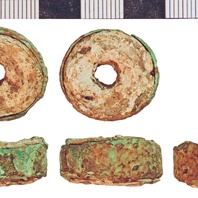
Viking Objects
Copper-Alloy Edged Lead Weight (NLM-E6E083)
A lead weight edged with a copper-alloy band. The distinction of weights by embedded objects or other embellishments in various media is a widely recognised feature of some early medieval weights. The object has also been identified as a spindle whorl, though this is less likely. If a weight, it is perhaps an indicator of the Scandinavian bullion economy. Weights are an important form of evidence for Viking Age commerce and the use of standards across the different economic systems within which Vikings were integrated. Many of the weights discovered, particularly ones in Ireland and those of Arabic type, suggest that a standardized system of weights existed in some areas. These standard weights, alongside standard values of silver, are what allowed the bullion economy of Viking occupied areas to function. A bullion economy was a barter economy that relied on the exchange of set amounts of precious metal in various forms, such as arm-rings or coins, for tradable goods, such as food or textiles. Each merchant would have brought their own set of weights and scales to a transaction to make sure that the trade was conducted fairly.
Read More
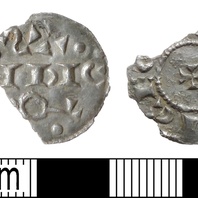
Viking Objects
Viking Silver Penny (DENO-7A0AF7)
An incomplete silver early medieval penny of the Vikings possibly minted in the name of Sihtric and imitating swordless St Peter Two-Line Type coins which were minted in York, c.905-920. Sihtric Caoch was the Scandinavian ruler of Dublin from 917-920 CE and subsequently the ruler of Northumbria from 921-927 CE. It is not certain why he left Ireland. The Irish annals state that it was ‘through the grace of God’ and do not elaborate on the politics behind his departure. After the establishment of the Danelaw, some Viking leaders decided to mint their own coins to solidify their legitimacy in the eyes of the local populace. This created a hybrid economy where some members of the Danelaw used bullion and others used coins.
Read More
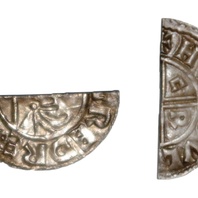
Viking Objects
Aethelred II Penny (LIN-8887C3)
A cut CRUX-type penny minted by Hundulf of York on behalf of King Aethelred II. While this coin is Anglo-Saxon, the fact that it has been cut may suggest that it was used as a part of a bullion transaction in line with the dual bullion-monetary economy established by the Vikings in England.
